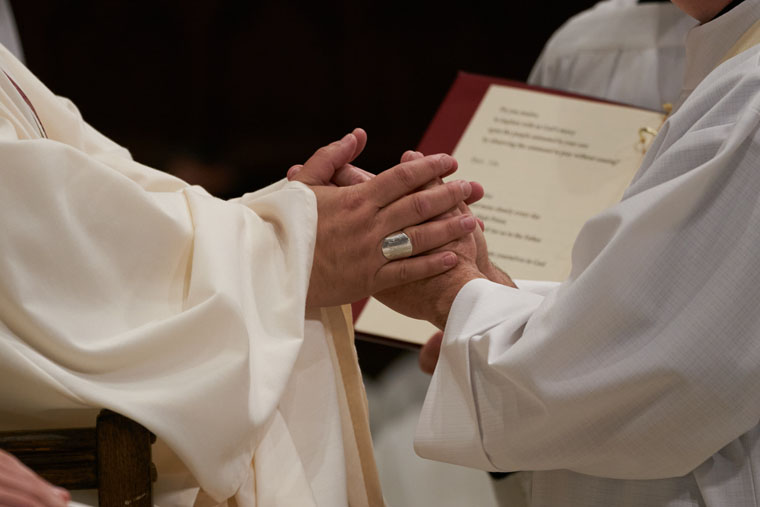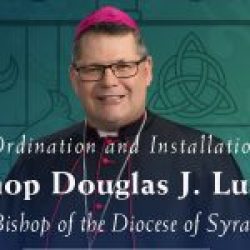Ordination is the sacramental ceremony in which a man becomes a deacon, priest, or bishop and is enabled to minister in Christ’s name and that of the Church (U.S. Conference of Catholic Bishops). The following explanation of the Rite of Ordination to the Priesthood is adapted from the video “Ordination 101,” produced by Father Joseph Scardella and Syracuse Catholic Television, and material from the U.S. Conference of Catholic Bishops; the text has been edited and condensed for clarity and length.
The Rite of Ordination always takes place within the Rite of the Mass. Mass begins with the Entrance Procession. The candidate for the priesthood walks in procession with the deacons, at the end of the line; he is still within that order, not yet a priest.
The Rite of Ordination begins immediately following the Gospel. The director of seminarian formation calls the candidate forward by name. He responds “present” and stands before the ordaining bishop.
The candidate is called from the midst of the people. The Church believes that those who are called to ministry answer the call from the Lord and are called from the midst of the Catholic community. For this reason, the candidate sits with his family until he is called forward for his ordination.
The Rite of Ordination continues with the Presentation of the Candidate. The bishop inquires of those charged with the spiritual and academic formation of the candidate, asking if the candidate has taken all the preparatory steps and been found worthy and competent to fulfill the Office of the Priesthood.
Upon affirming the candidate, the bishop elects him for ordination and asks the people to affirm this election by applause.
The bishop then proceeds with his homily, which, along with a reflection on the Scriptures of the day, includes an instruction to the candidate regarding what the Church will expect of him in his new role as a priest.
In the Examination of the Candidate, the bishop asks the candidate to speak of his willingness to be ordained. The candidate answers each question put to him with an affirmation, “I am,” and to the last of the bishop’s questions, “I am with the help of God.”
The rite continues with the Promise of Obedience. The candidate steps forward to promise obedience to the bishop and his successors as a priest who will be under the care, guidance, and direction of the diocesan bishop. The Promise of Obedience assures that both priest and bishop will work hand in hand to build the kingdom of God. As a symbol of this obedience, the candidate places his folded hands within the folded hands of the bishop.
The bishop then calls the congregation to prayer. The Church calls upon those who are saints to intercede on behalf of the candidate as he approaches the Sacrament of Holy Orders. This is called the Litany of Supplication. This litany of the saints reminds us of the Universal Call to Holiness and the special call to holiness that marks the life of a priest. The candidate prostrates himself while the assembly prays. The gesture of prostration is a symbol of submission to the will of God. The bishop ends the litany with a prayer.
The essential rite of the sacrament — when the ordination takes place — is the laying on of hands and the Prayer of Consecration (USCCB).
The ordinand kneels before the bishop, who prays in silence, placing his hands on the head of the candidate and calling upon the Holy Spirit. This gesture was first recorded in the Scriptures, when the apostles elected the first deacons to service in the Church. By the same ritual act, priests present come forward and impose hands upon the candidate. “By this ritual the ordaining bishop and the other priests invoke the Holy Spirit to come down upon the one to be ordained, giving him a sacred character and setting him apart for the designated ministry” (USCCB).
The priests then raise their hands in blessing as the bishop prays the Prayer of Consecration. The assembly responds “Amen” to the bishop’s prayer as a sign of their assent to the sacred action that has taken place.
The newly ordained priest then removes his deacons’ stole and is vested in the priests’ stole, symbolizing the authority and responsibility to serve in imitation of Christ (USCCB), and the chasuble, the vestment worn for the celebration of the Mass.
The bishop then anoints the priest’s hands with Sacred Chrism. “The anointing of the hands signifies that the hands of the newly ordained priest are being prepared for the sacred duties and vessels which will be part of the priestly ministry” (USCCB). His hands are anointed so that, like Jesus, he may be a servant to the people of God, leading them to the love of the Father through his celebration of the sacraments and his example.
The Presentation of the Gifts occurs; usually members of the new priest’s family bring the gifts of bread and wine to the bishop. The deacon of the Mass prepares the chalice for the Mass and then brings it to the bishop. The bishop then places the paten with the host and the chalice with unconsecrated wine into the hands of the new priest and says, “Receive the oblation of the holy people to be offered to God. Understand what you do, imitate what you celebrate, and conform your life to the mystery of the Lord’s cross.” In this presentation, the bishop exhorts the new priest to live the mystery of the Eucharist in his own life, giving his life as Jesus did for the eternal life of the faithful.
The Rite of Ordination concludes with the Sign of Peace. Having been given the gifts to exercise his office, the new priest is welcomed into the Order of the Priesthood first by the bishop and then by his brother priests.
The Liturgy of the Eucharist is then celebrated by the bishop, with the newly ordained taking a prominent role in his first celebration of the Eucharist as a priest.





